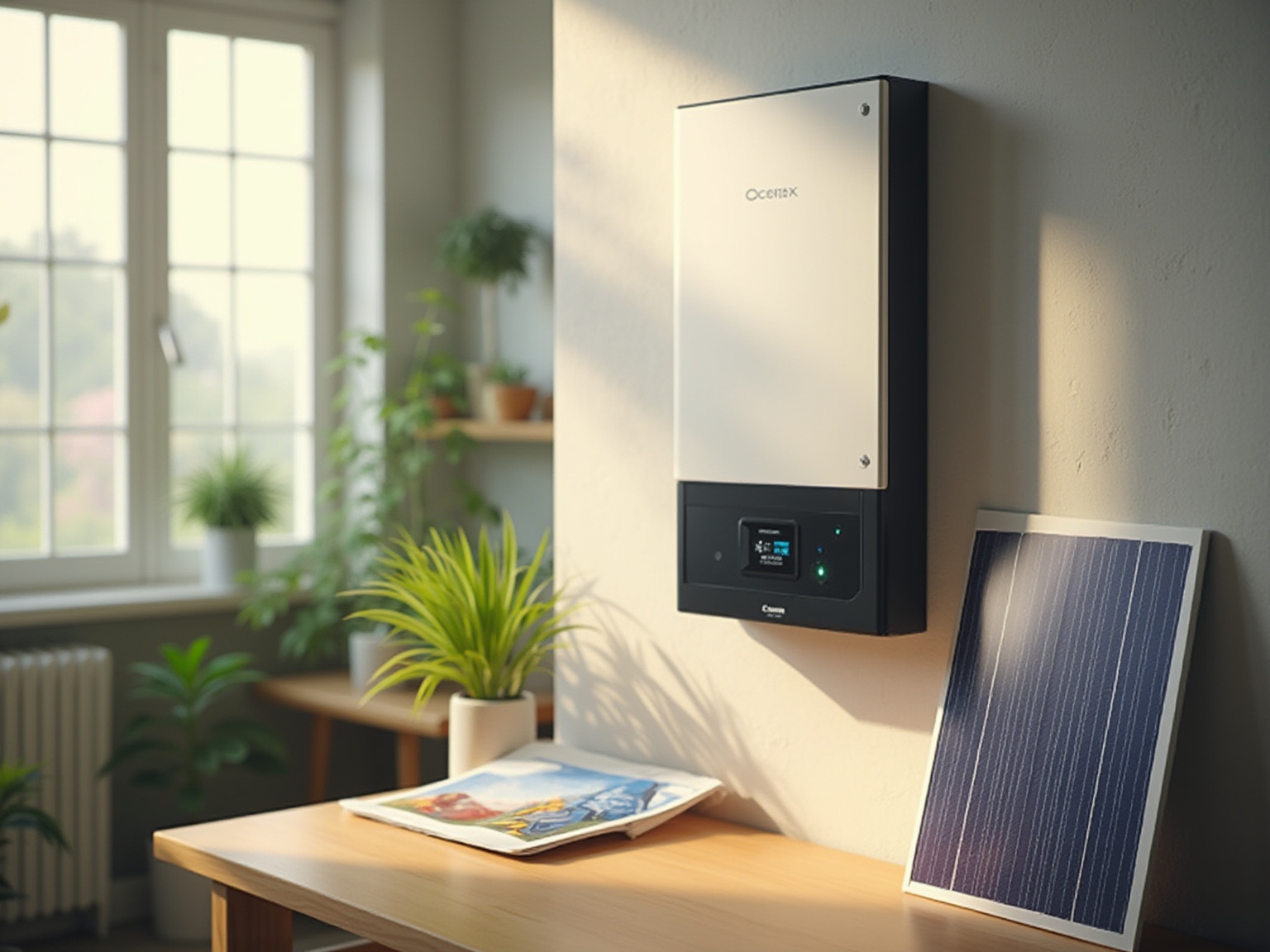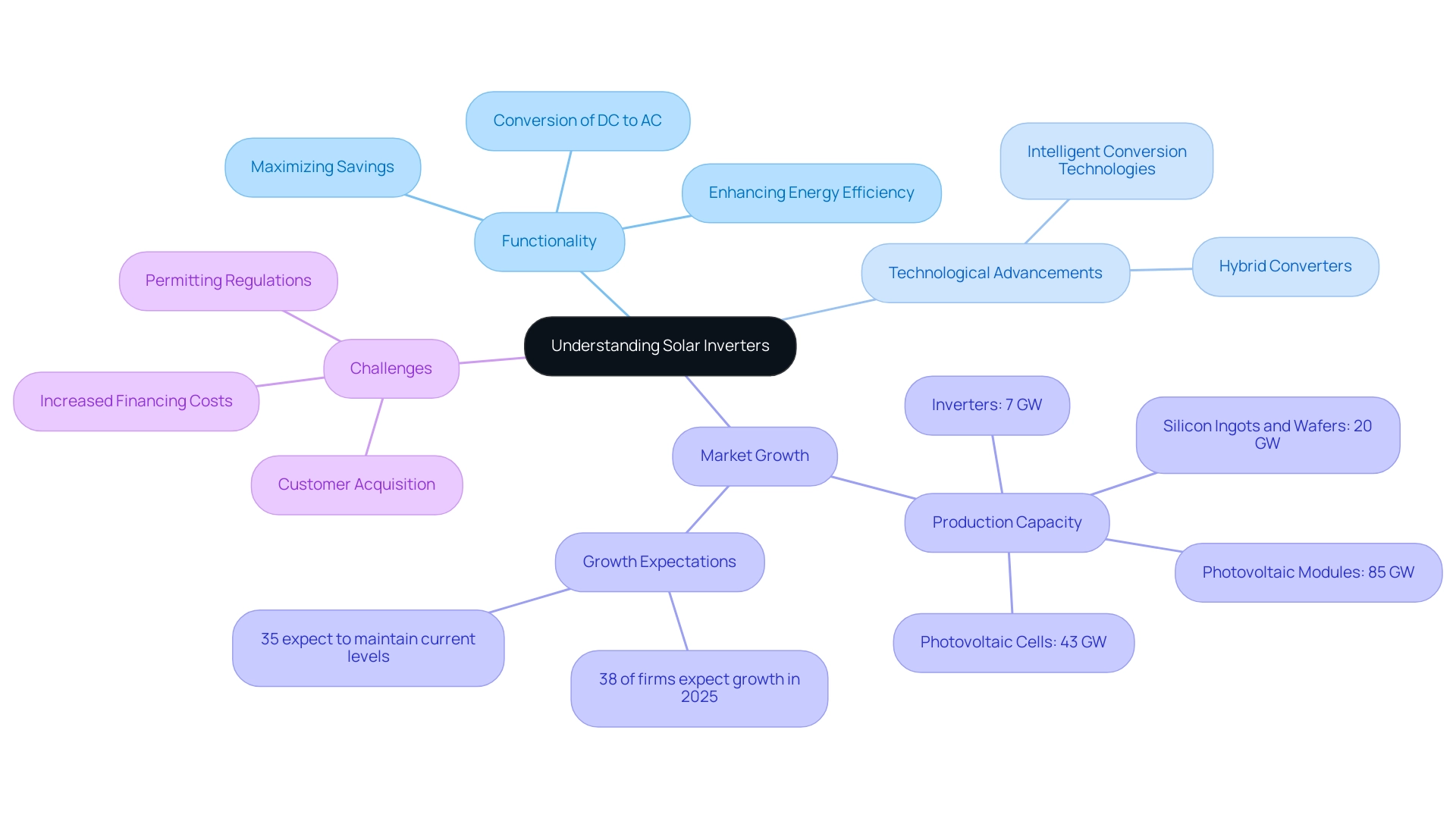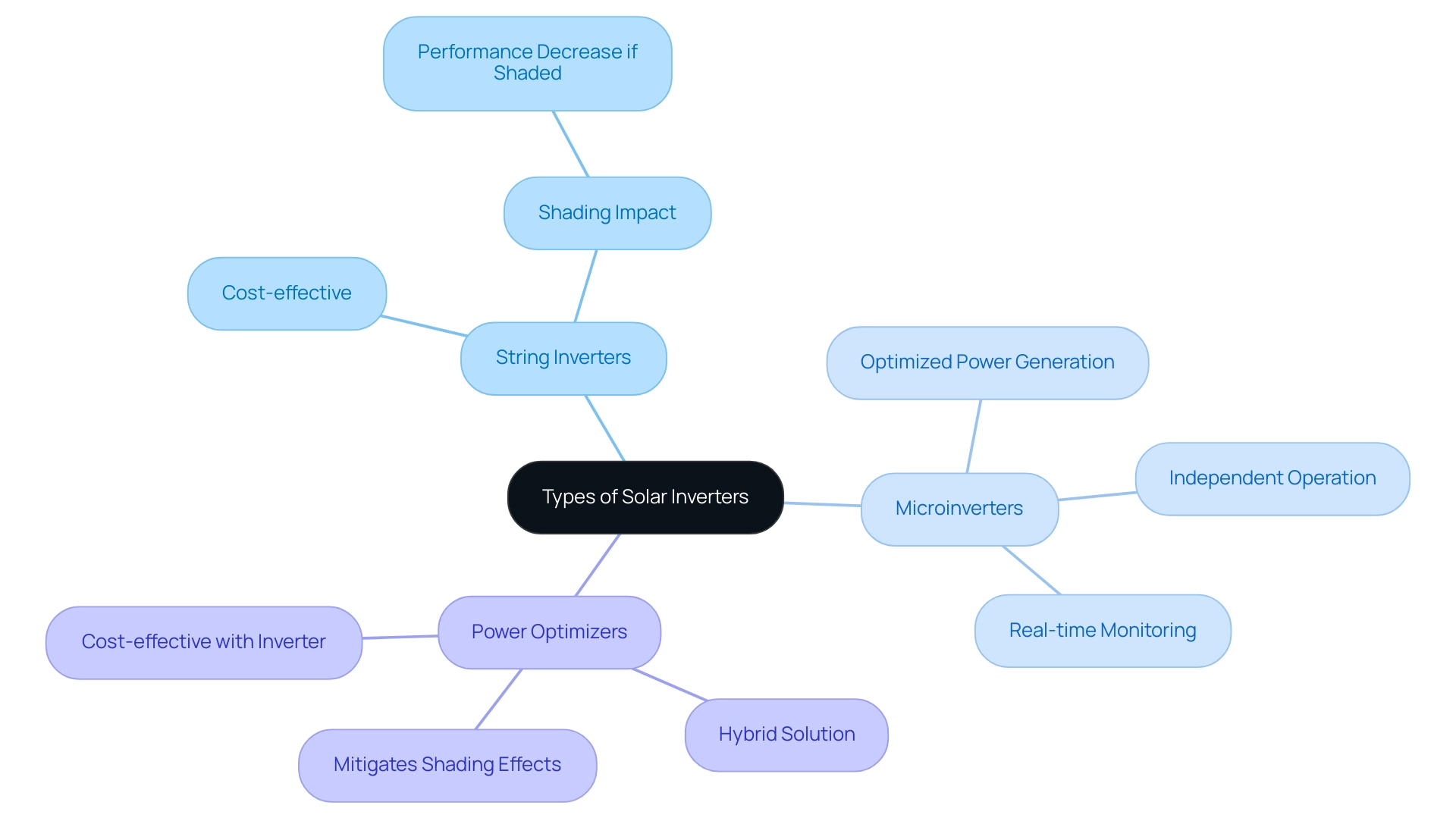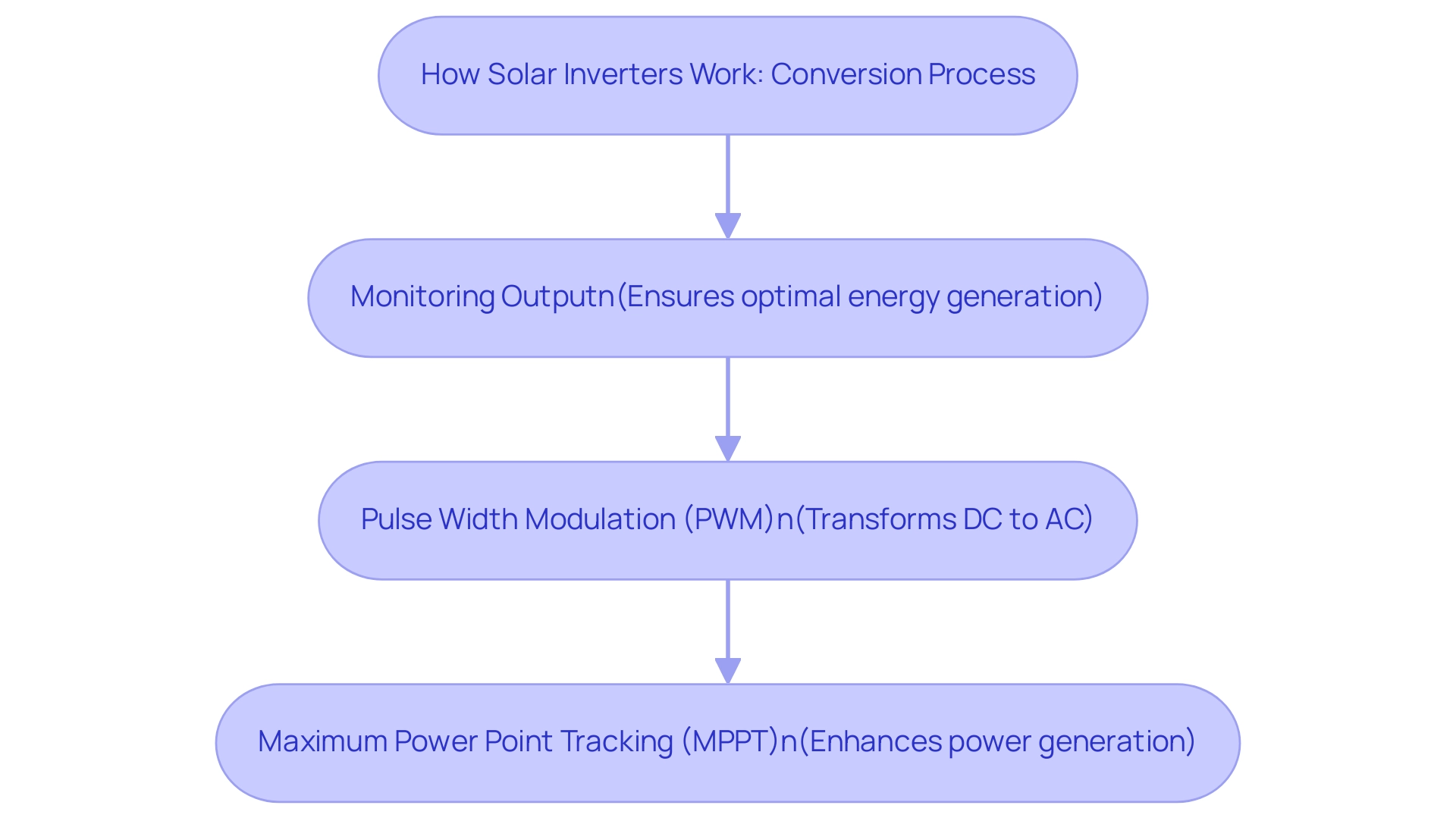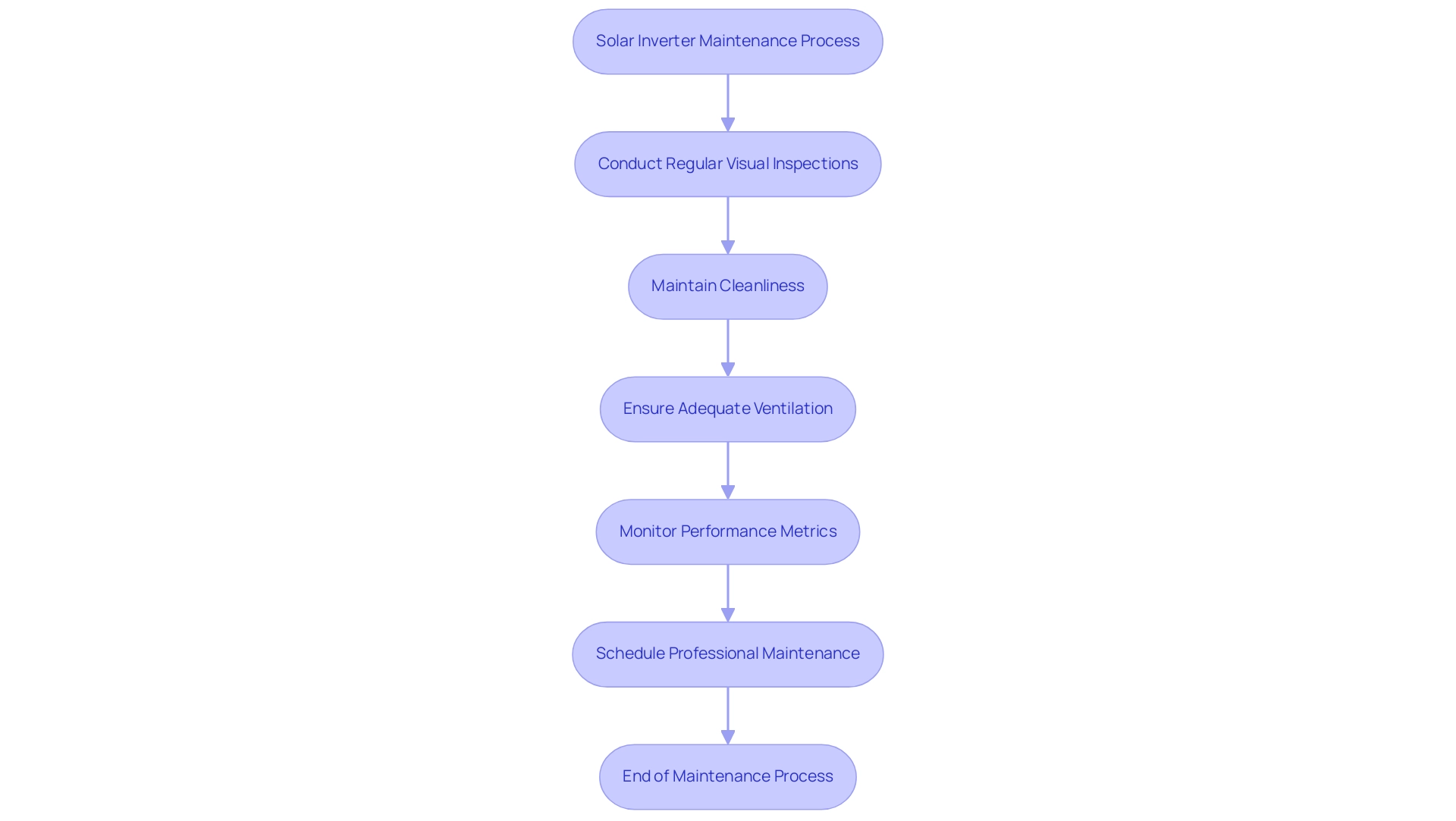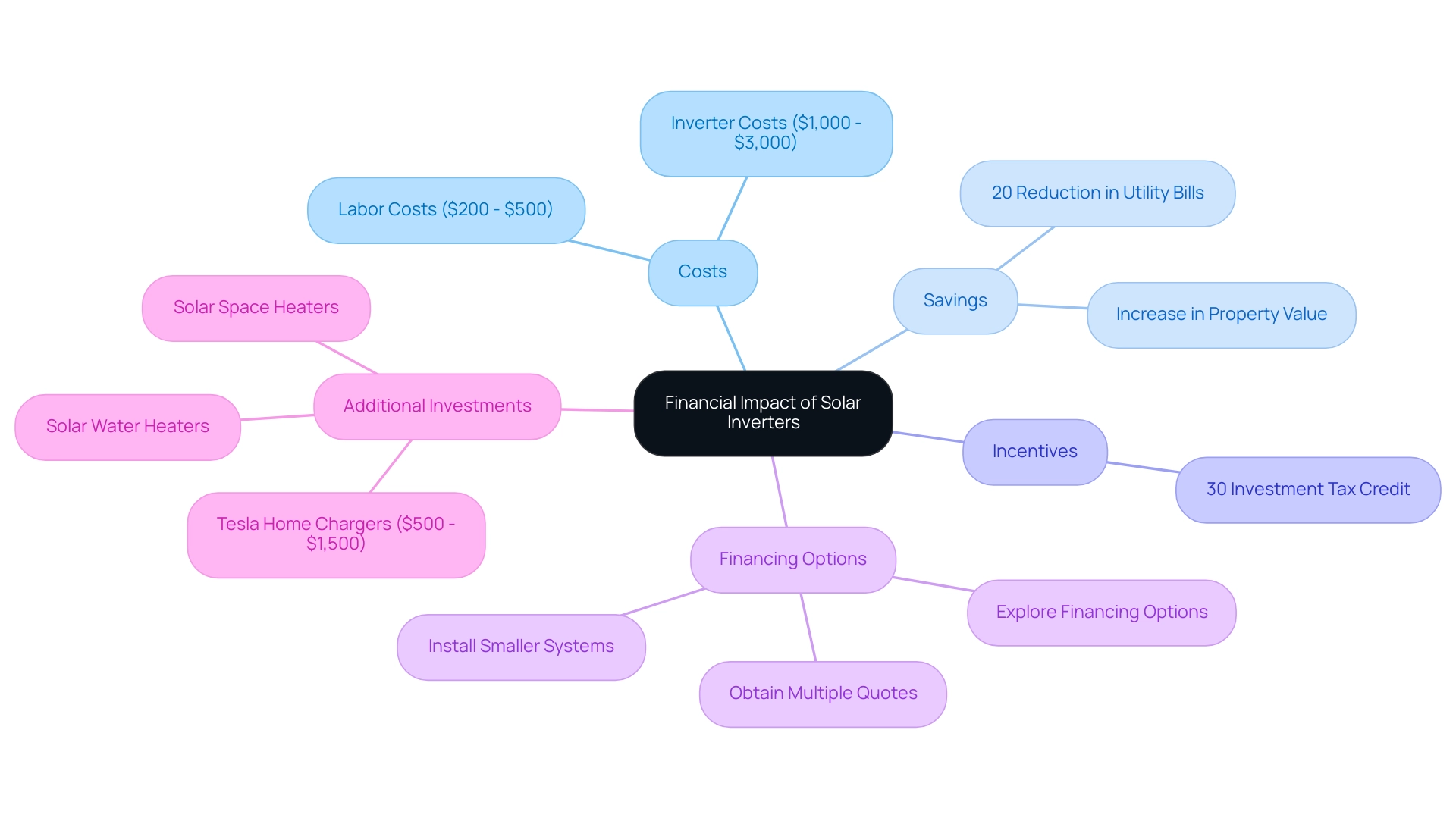Overview
The article “Caring for Our Planet: A Complete Guide to Solar System Inverters for Eco-Conscious Homeowners” addresses the concerns many homeowners have about rising energy bills and the quest for sustainable solutions. It emphasizes the importance and functionality of solar system inverters in optimizing energy use, providing a pathway towards energy independence. These vital devices convert DC electricity from solar panels into usable AC electricity, enhancing efficiency and savings.
As you explore the benefits of solar energy, it’s reassuring to know that advancements in inverter technology continue to improve performance and reliability. Moreover, financial incentives are available to support your transition to solar energy solutions, making it an even more appealing choice.
We understand that making the switch to solar can feel overwhelming, but together we can navigate this journey towards a more sustainable future. By embracing solar energy, you not only reduce your energy costs but also contribute to a healthier planet. Let’s work towards a brighter tomorrow, and if you have any questions or need guidance, we’re here to help every step of the way.
Introduction
As we navigate the rising costs of energy bills, many homeowners are understandably concerned about their financial future. We recognize that these worries can be overwhelming, but there is hope in the form of sustainable energy solutions. Solar inverters, often overlooked, are the unsung heroes of solar energy systems. These essential components transform the direct current (DC) generated by solar panels into the alternating current (AC) that powers our everyday household appliances, making solar energy both usable and efficient.
With advancements in technology, such as hybrid and smart inverters, homeowners now have access to tools that not only enhance energy savings but also provide real-time monitoring capabilities. Imagine having the power to track your energy usage and optimize your savings—this is the promise of modern solar technology. As the solar inverter market continues to expand, understanding the different types available becomes crucial for homeowners who wish to maximize their solar investments.
Here are some key benefits of solar inverters:
- Energy savings: Reduce your monthly bills and gain energy independence.
- Real-time monitoring: Stay informed about your energy consumption and performance.
- Increased home value: Solar installations can enhance your property’s market appeal.
This article delves into the intricacies of solar inverters, exploring their functionality, the pros and cons of various types, and the significance of proper maintenance. Together, we can ensure that you are well-informed to make the best choices for your energy needs. Let’s work towards a sustainable future, where you can enjoy peace of mind and financial relief through solar energy.
Understanding Solar Inverters: The Heart of Solar Energy Systems
We understand that rising energy bills can be a source of stress for many homeowners. Devices that convert electricity, such as the solar system inverter, play a crucial role in photovoltaic systems by bridging the gap between the direct current (DC) generated by photovoltaic panels and the alternating current (AC) that powers most home appliances. Without these essential components, the energy collected from photovoltaic panels would remain impractical for everyday use. These converters not only facilitate this vital transformation but also enhance the overall power output from photovoltaic panels, empowering homeowners to maximize their savings and operational efficiency.
Recent advancements in photovoltaic converter technology have introduced hybrid converters that seamlessly integrate with power storage systems, paving the way for greater flexibility and efficiency in managing energy. Moreover, the rise of intelligent conversion technologies further enhances this capability, enabling real-time monitoring and optimization of power consumption. As we look towards 2025, the photovoltaic inverter market is witnessing significant growth, with the U.S. photovoltaic supply chain boasting 155 GW of new production capacity. This includes:
- 85 GW of photovoltaic modules
- 43 GW of photovoltaic cells
- 20 GW of silicon ingots and wafers
- 7 GW dedicated solely to inverters
The importance of solar system inverters in residential power systems cannot be overstated. They are essential for ensuring that homeowners can effectively utilize the energy produced by their panels, particularly through the use of a solar system inverter. This is especially relevant given the challenges posed by escalating electricity costs and power interruptions. For instance, a recent case study revealed a 4% decline in residential energy installations in Q3 2024, attributed to high electricity bills and changes in California’s net metering regulations.
This decline underscores the necessity for effective devices that can optimize savings and enhance system performance. Efficient solar system inverters can help address these challenges by ensuring that residents make the most of the energy harvested from their photovoltaic systems, even in a fluctuating market.
Experts in the renewable energy sector emphasize that converters are vital for maximizing savings. As the sector evolves, the role of solar system inverters will become increasingly important in helping residents achieve energy independence and sustainability. With 38% of photovoltaic firms anticipating growth in 2025 and an additional 35% expecting to maintain their current business levels, the focus on innovative solar system inverter technologies is poised to significantly influence the future of residential power systems.
As homeowners explore optimal battery options for efficient energy storage, understanding the significance of battery capacity and power ratings will be crucial for effective resource management and long-term sustainability. However, challenges such as permitting and interconnection regulations, customer acquisition, and rising financing costs remain significant hurdles that the industry must overcome. Furthermore, integrating Tesla home chargers with renewable energy systems can enhance energy efficiency, while government programs for renewable energy provide valuable resources for individuals seeking to invest in this technology. Together, we can navigate these challenges and work towards a more sustainable future.
Exploring Different Types of Solar Inverters: Which One is Right for You?
When it comes to photovoltaic converters, we understand that property owners often feel overwhelmed by the choices available. Typically, there are three main categories to consider: string converters, micro converters, and power optimizers. String devices are the most common option for residential setups, linking several solar panels in a series. While this configuration can be cost-effective, it’s important to note that if one panel is shaded, the performance of the entire string may be affected, leading to decreased efficiency.
In contrast, microinverters, which are installed on each individual panel, allow them to operate independently. This design optimizes power generation, particularly in scenarios where shading is a concern, making microinverters an appealing choice for residents with partially shaded roofs. Additionally, many solar system inverters come equipped with robust monitoring capabilities, enabling homeowners to track the performance of each panel in real-time. Power optimizers serve as a hybrid solution, working alongside solar system inverters to enhance the performance of photovoltaic panels by mitigating the impacts of shading and maximizing power output, while still benefiting from the cost-effectiveness of a solar system inverter.
As we look towards 2025, market dynamics indicate a growing preference for microinverters. Industry statistics show that 78% of installers anticipate an increase in renewable sales this year, reflecting a broader shift towards more efficient and reliable solar solutions. Significantly, in 2024, 80% of property owners who set up battery systems indicated that backup power was their primary motivation, underscoring the importance of dependable power sources in home environments.
When choosing the right solar system inverter type, it’s essential for homeowners to thoroughly evaluate their specific installation circumstances and power requirements. Understanding the unique advantages of each type of solar system inverter can significantly influence overall system performance and energy savings. For instance, Jason Svarc, a certified energy and battery expert, emphasizes the importance of selecting quality, dependable systems tailored to individual household needs.
At Powercore Electric, our in-house team of experts is dedicated to ensuring high-quality installations and maintenance for your renewable energy and electrical needs. We want you to feel confident that your systems are installed correctly and efficiently, giving you peace of mind.
In practical terms, real-life examples illustrate how residents have successfully navigated these choices. For example, a case study on the Solax X1 Boost Inverter showcases its simplicity and reliability, positioning it as an economical option supported by a strong global network. This inverter’s robust online monitoring platform further enhances user experience, allowing residents to stay informed about their energy production.
Ultimately, the decision on which inverter to choose should be guided by a combination of your personal energy goals, installation specifics, and the latest market trends. This approach ensures that you can make the most of your renewable energy investments. At Powercore Electric, our commitment to outstanding service and local knowledge will help you make informed choices that align with your eco-conscious values. Many satisfied customers have praised Powercore Electric for our efficiency and community focus, reinforcing our dedication to providing exceptional energy solutions tailored to the needs of California homeowners.
How Solar Inverters Work: Converting Sunlight into Usable Energy
We understand that rising energy bills can be a significant concern for homeowners. Devices that convert sunlight, such as a solar system inverter, play a vital role in addressing this issue. By transforming the direct current (DC) electricity produced by solar panels into alternating current (AC) electricity, these devices enable you to power your household appliances and connect seamlessly with the power grid.
The conversion process involves several key steps:
-
Monitoring Output: The device consistently observes the output of the photovoltaic panels, ensuring optimal energy generation while adapting to variations in sunlight intensity and angle.
-
Pulse Width Modulation: Utilizing a technique known as pulse width modulation (PWM), the device rapidly switches the direction of the DC input. This method effectively transforms the DC electricity into AC output, making it suitable for household applications or allowing it to be sent back to the grid.
-
Maximum Power Point Tracking (MPPT): Contemporary photovoltaic converters come equipped with advanced features like maximum power point tracking (MPPT), which enhances power generation by modifying the electrical operating point of the modules. This ensures peak effectiveness even under varying sunlight conditions.
As we look ahead to 2025, the efficiency rates of modern solar system inverters have significantly advanced, with numerous models achieving conversion efficiencies surpassing 98%. This remarkable progress not only maximizes power output but also enhances the overall performance of photovoltaic systems, particularly when utilizing a solar system inverter.
Moreover, understanding the best battery options for power storage is essential for property owners aiming to optimize their investment in renewable systems. By choosing the appropriate battery systems, you can store surplus power generated during peak sunlight hours for use in the evening or on overcast days, thereby improving your energy autonomy.
Powercore Electric’s in-house team of specialists guarantees high-quality installations and maintenance, providing you with the confidence that your renewable power systems are optimized for performance and dependability. Practical instances demonstrate the efficiency of photovoltaic conversion technology. For example, many residential setups have noted significant decreases in utility expenses, with residents benefiting from the ability to store surplus power produced during peak sunlight periods.
As the photovoltaic supply chain anticipates the inclusion of 155 GW of new production capability, comprising 85 GW of module capacity, the incorporation of high-efficiency converters will be crucial in fulfilling the increasing demand for sustainable power solutions. This signifies that eco-aware property owners can look forward to even greater power savings and improved sustainability from their photovoltaic systems.
By grasping how photovoltaic converters change DC to AC electricity and understanding the significance of selecting the appropriate battery options, you can make informed choices about your renewable power systems. Together, we can ensure that you utilize clean power effectively and sustainably.
Pros and Cons of Solar Inverter Types: Making the Best Choice for Your Home
When considering photovoltaic converters, we understand how important it is to evaluate the benefits and drawbacks of each option, especially as you look to integrate electric vehicles with renewable energy for sustainable driving solutions. Powercore Electric offers a variety of energy devices tailored to meet diverse residential needs. Many homeowners favor string converters for their affordability and straightforward installation, which makes them a popular choice.
However, it’s common to feel concerned about efficiency, as shading on even a single panel can significantly impact overall system performance. In contrast, microinverters shine in terms of efficiency and adaptability, particularly in shaded environments, though they typically come with a higher initial investment. As Jason Svarc, an accredited solar and battery expert, notes, “The new generation TL-X power conversion range is modern looking and available in a range of sizes from 2.5kW to 6.0kW,” which Powercore Electric provides, ensuring you have access to the latest technology.
Power optimizers present a practical solution, enhancing the efficiency of string systems without the full cost associated with micro units. This option can be especially beneficial for homeowners with partially shaded roofs or those seeking to maximize energy output, particularly when considering the integration of electric vehicles. Powercore Electric’s offerings include optimizers designed to help you achieve this balance.
Looking ahead to 2025, the cost of replacing a power converter may range from $200 to $500 for labor alone. This highlights the importance of making a thoughtful choice from the outset. Additionally, most photovoltaic converters come with warranties—micro converters are generally protected for up to 25 years, while string converters are covered for up to 10 years—providing you with assurance about their durability and reliability. Powercore Electric’s devices feature competitive warranties, ensuring your satisfaction.
As you assess your specific power requirements, budget considerations, and installation circumstances, it’s vital to identify the most appropriate solar system inverter for your photovoltaic setup. By doing so, you can ensure optimal performance and long-term savings, while also taking advantage of the current incentives available for renewable power adoption in 2025. The case study ‘Why 2025 Is the Perfect Year to Go Renewable’ emphasizes the financial, environmental, and technological motivations for embracing renewable energy now, encouraging homeowners to invest in sustainable energy options that enhance their electric vehicle usage.
At Powercore Electric, we are committed to helping you navigate these options effectively. Together, we can work towards a brighter, more sustainable future.
Maintaining Your Solar Inverter: Tips for Longevity and Efficiency
To ensure the longevity and optimal performance of your solar system inverter, we understand how important it is to adopt a proactive maintenance approach. Here are several key practices to consider:
- Conduct Regular Visual Inspections: Frequently check your device for any signs of wear, damage, or unusual indicators that may suggest a malfunction.
- Maintain Cleanliness: Keeping the device free from dust and debris is crucial, as accumulated particles can hinder its cooling efficiency, potentially leading to overheating.
- Ensure Adequate Ventilation: Proper airflow around the device is vital to prevent overheating. Make sure there are no obstructions that could impede ventilation.
- Monitor Performance Metrics: Regularly track performance metrics to detect any drops in efficiency. This proactive measure can help identify issues early on, allowing for timely interventions.
- Schedule Professional Maintenance: It’s advisable to arrange for professional maintenance checks at least once a year. These inspections can help address potential issues before they escalate into significant problems, ensuring your system operates smoothly.
In 2025, statistics suggest that routine upkeep can considerably prolong the lifespan of photovoltaic converters, with properly maintained systems demonstrating a longevity of 15 to 20 years. Experts in the field emphasize that consistent upkeep of the solar system inverter not only enhances its efficiency but also mitigates common issues such as overheating and performance drops. For instance, a case study titled “Challenges and Resilience in Pricing” highlighted how a homeowner’s solar system inverter, maintained through diligent care, outperformed similar systems by 20% over five years, illustrating the impact of maintenance on performance amidst the complexities of pricing.
Additionally, understanding the functionality of your energy panels is crucial. Solar panels convert sunlight into electricity, and their efficiency can be affected by factors such as shading, orientation, and cleanliness. Choosing the best battery options for power storage is just as crucial, as it guarantees that the power produced can be stored and utilized efficiently, improving the overall effectiveness of your system.
It’s common to feel concerned about noise pollution from PV systems, particularly from the solar system inverter. Tackling this problem through correct installation and upkeep can improve the overall experience of utilizing renewable power.
As Anna Brui, a writer passionate about renewable energy and sustainability, observes, “The shift to renewable energy sources is not merely about installation; it’s about continuous maintenance and comprehending the wider implications of our energy selections.” By applying these maintenance techniques, together we can enhance the performance and lifespan of your energy converter, ensuring that your investment remains profitable for years ahead.
The Financial Impact of Solar Inverters: Costs, Savings, and Incentives
Are you feeling the weight of rising energy bills? You’re not alone. Many homeowners are concerned about the costs associated with energy consumption, and it’s completely understandable. As we look towards 2025, the price of photovoltaic converters varies significantly, typically ranging between $1,000 and $3,000. This range reflects the differences in system size and type, with microinverters often found at the higher end due to their advanced technology and efficiency. By investing in a premium converter, you not only secure improved performance but also pave the way for substantial savings in the long run.
In California, the expenses align with national trends, yet there are various incentives available that can make renewable energy sources more accessible. For instance, the Investment Tax Credit allows homeowners to deduct 30% of their installation costs from their federal tax return, potentially saving thousands on their energy systems. This motivation is crucial for enhancing savings and easing the transition to renewable energy, especially when it comes to utilizing a solar system inverter.
But the financial benefits don’t stop at the initial investment. Homeowners can expect a return on their investment through reduced utility bills and an increase in property value by opting for a solar system inverter. A case study revealed that property owners who selected high-quality photovoltaic systems enjoyed an average reduction of 20% in their utility expenses each year, showcasing the lasting advantages of choosing superior technology.
Moreover, integrating Tesla home chargers into your renewable energy system, alongside a solar system inverter, can boost energy efficiency and sustainability, offering a dual benefit for those who care about the environment.
To alleviate upfront costs, consider exploring financing options, installing smaller systems, and obtaining multiple quotes from different installers. These strategies can significantly ease the initial financial burden associated with photovoltaic converter installation.
It’s also important to factor in labor costs for converter installation, which typically range from $200 to $500. Most photovoltaic converters come with warranties that provide peace of mind; microinverters often offer coverage for up to 25 years, while string converters usually cover up to 10 years. This warranty duration emphasizes the reliability of quality inverters and their role in ensuring ongoing savings over time.
As you contemplate the financial implications of inverters, consulting with financial advisors can provide valuable insights into the cost reductions associated with these investments. Understanding the long-term financial impacts will empower you to make informed decisions regarding the use of a solar system inverter that aligns with your eco-conscious values while enhancing your self-sufficiency. Additionally, looking into government initiatives and cleaning solutions for photovoltaic panels can improve the efficiency and longevity of your renewable energy systems.
Alongside energy inverters, it’s essential to consider the expense of Tesla home chargers, which generally range from $500 to $1,500, depending on the model and installation requirements. This investment enhances photovoltaic systems by enabling residents to charge their electric vehicles sustainably. Furthermore, top solar-powered heating solutions, such as solar water heaters and solar space heaters, can yield significant energy savings and improve overall home efficiency, making them worthy considerations for eco-conscious homeowners.
Together, we can explore these options and find the best path towards a sustainable and cost-effective energy future.
Conclusion
We understand that managing energy bills can be a significant concern for homeowners. That’s why understanding the integral role of solar inverters is crucial for those looking to harness the full potential of solar energy systems. These devices not only convert the direct current (DC) generated by solar panels into usable alternating current (AC) but also enhance energy efficiency and savings. With advancements such as hybrid and smart inverters, you can now monitor your energy usage in real-time and optimize your consumption. This leads to greater financial independence and a more sustainable lifestyle.
Choosing the right type of inverter—whether string inverters, microinverters, or power optimizers—depends on your individual needs and installation conditions. Each type comes with its own set of advantages and disadvantages, impacting overall performance and energy output. By assessing your specific circumstances and understanding market trends, you can make informed decisions that maximize your solar investments.
Proper maintenance of solar inverters is equally essential for ensuring longevity and efficiency. Regular inspections, cleanliness, and professional maintenance can significantly extend the life of these systems, allowing you to reap the benefits of reduced energy costs and enhanced property value over time. Furthermore, understanding the financial implications, including upfront costs, incentives like the Solar Investment Tax Credit, and potential returns on investment, empowers you to take confident steps towards adopting solar technology.
As the solar energy landscape continues to evolve, investing in quality solar inverters and implementing effective maintenance strategies will not only contribute to your personal financial relief but also support a broader transition towards sustainable energy solutions. Together, we can embrace these advancements and pave the way for a brighter, eco-friendly future where you can enjoy the benefits of clean, renewable energy.


